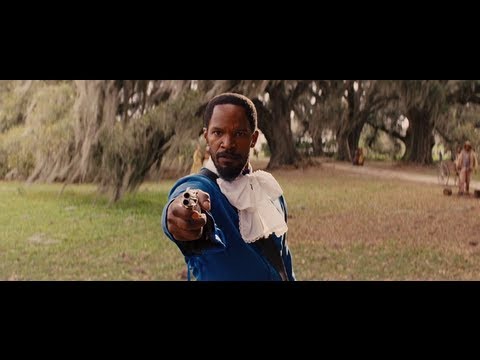34.21: Technology’s Impact on Literature
- Page ID
- 40915
For this project, I wanted to pick a contemporary text that connects to the texts about slavery that we have been reading and breaking down in class. In this post, I will discuss how technology can be used as a form of entertainment and how it helps members of our society learn. I will also be comparing and contrasting the differences between films and books such as Django Unchained and The Heroic Slave.
The contemporary text I chose is called Django Unchained, a film that was released on December 25th, 2012. The Legendary Quentin Tarantino had written and directed this film, which is a story that takes place two years after the Civil War. Spoiler alert: This is a story that introduces a slave named Django (played by Jamie Foxx), who is accompanying an unorthodox German bounty hunter named Dr. King Schultz (played by Christoph Waltz). At the beginning of the film, a few slaves are traveling with their slave owners until Dr. King Schultz arrives. Dr. King Schultz then buys Django and kills the wanted slave owners because they had a bounty on their head. From here, their adventure begins to free Django’s wife from slavery as well as hunting down the wanted slaveowners. Throughout their adventures, we see the effects slavery has on the people and the separation it creates between the individuals of society at this time.
Django: Unchained, asa film about slavery, seems easy to compare it to any of the texts about slavery that we have read and discussed in class. Although, I feel that The Heroic Slave has similarities and differences with Django: Unchained. An analogy to this is that both of the protagonists Django (Django: Unchained) and Madison Washington (The Heroic Slave) wanted to reach freedom and ultimately free their wives as well. Spoiler alert: The difference is that in the end, Django is successful with freeing his wife by having Dr. King Schultz buy her for 12,000 dollars, and both Django and Dr. King Schultz having to kill many people along their adventure. The Heroic Slave’s protagonist Madison Washington fails to free his wife, and she ends up being shot and killed in the process of escaping. Moreover, The Heroic Slave is a real slave narrative, while Django: Unchained was created by Quentin Tarantino as an action movie. Django is more of a sidekick to Dr. King Schultz and less of the typically bought slave. The use of technology is what really created the viewpoint I have towards Django: Unchained as more of an action movie than a slave narrative.
Now, through the use of technology and the existence of films, members of our society can see that there are significant differences between a book and a film. Many people in society can sit through a very long movie–Django: Unchained is a two-hour-and-forty-five-minute movie–while many people have trouble making it through a whole book or even the halfway point. Although, through films, the audience can gain a better understanding of a story and the audience will gain more information, while some people find themselves very lost and confused when reading specific texts. Django: Unchained entirely relies on visuality and technology to tell the audience the story, as well as show detail, which introduces the use of music to create tension and show the surrounding environment between the characters in a particular situation. This film is very vulgar and violent and the use of special effects or props is what really illustrates the details in this movie, and sometimes leaves the audience disgusted at what they had just seen or heard (I know I was). Throughout the film, the actors say the N-word a total of 109 times (Quora.com), and every time it hurt my ears to hear, leaving me feeling impacted. The violence shown through the use of technology in this movie left a significant impact on me; it is very different to read about the vulgarity and violence then it is to see the violence happening right in front of your eyes in the film. Below, I have provided a scene from the film to back up the claims I have made about the use of technology in this movie, such as the music, special effects, and violence. Warning: The scene has a very strong use of language and shows a lot of violence.
Overall, I think the use of technology in order to create films has opened another world for many people to tell stories, and even retell stories of old, if not very old books (Early American Literature). Movies show an immense amount of visual and auditory detail that the audience is not able to receive from just reading a book. Now our society has gone from relying on written literature to relying on technology to tell and provide a story to an audience. Technology has opened a lot of gateways to learning, gaining more knowledge, and bringing people together. I have seen the use of technology used in our class, such as our use of Hypothes.is. This technological program has allowed us, readers, to annotate, allowing us to express our thoughts and opinions, and even learn from other classmates as well. I am very excited to see where technology brings us in the future, although I think we as a society must continue to read and learn from early American hard-copy texts that the general public cannot access online.
Work Cited:
Hypothes.is
Django: Unchained: Brittle Brothers scene (Youtube)
Www.Quora.com
Douglass, Frederick, Robert S. Levine, John Stauffer, and John R. McKivigan. The Heroic Slave: A Cultural and Critical Edition. , 2015. Print.



